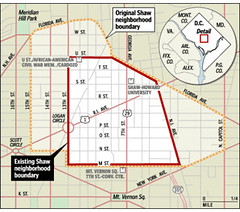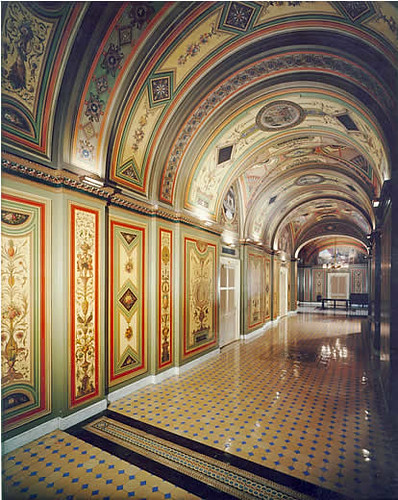Revitalizing places that are contested spaces
 Washington Post graphic.
Washington Post graphic.A couple weeks ago there was an article in the Post about change in Shaw, "A Bittersweet Renaissance." I didn't write about it because I've heard the arguments many times before. From the article:
But this is not just any neighborhood. These owners are nagged by something deeper and more complicated than how far their new wealth would take them or how they would adjust to new surroundings. They fret about the future identity of the neighborhood, a bastion of black culture and history -- their history -- where Langston Hughes wrote poetry and Duke Ellington played piano, where African Americans started their own bank, built their own buildings and thrived for generations...
He recalls an encounter he had one afternoon when it still was warm, an encounter not unfamiliar: An African American woman stopped for a red light and called to him as he swept the sidewalk in front of his steps. Was he the owner? He nodded. Don't sell, she said. No matter what they offer you. Pass it on, keep it in the family. She drove away, Lofton said, but the message stayed: Keep the neighborhood as it was. Keep it black.
Note that these sentiments aren't much different from the controversial op-ed by a Post journalist in the Sunday Outlook section of the Post, "I Won't Let D.C. Lose Its Flavor," back in 2001.
Today's Post has a number of letters to the editor in response, "A Disturbing Snapshot Of Shaw," mostly focusing on what the writers see as a form of reverse racism. This letter by John Essex of University Park, Maryland, captures such sentiments:
What claptrap. Without even a whiff of irony, we read repeatedly that the blacks in Shaw are uncomfortable with, and even downright opposed to, whites moving back to the area. Read these two sentences from the article, and then replace the word "black" with "white".
Those residents of Shaw upset by the changes should repeat my mantra: "All things flow, nothing abides." What they consider "their" neighborhood was once different: In the late 19th century, it was home to my (white) great-great-grandparents. Shaw resident Moses Lofton doesn't seem to know this, as the article proves: "Whatever he decides, and whenever he decides, he said, he hopes an African American is the buyer, if only to evoke the past." If he wants to evoke the past, maybe we should give the land back to whichever Indian tribe lived there..
Something I wrote last summer, which is an on-going re-write of thoughts developed over the past few years, "More about Contested Space--"Gentrification"" addresses these kinds of sentiments, in what I call Gentrification effect #2 --
But gentrification is phenomenon with multiple effects, which I describe as: ...
(2) change and different people coming into a neighborhood -- most importantly, different people from those currently in residence (the differences--race, class, ethnicity, levels of educational attainment, attitudes toward the urban experience, etc.--are usually not "celebrated" (I make this point because I still remember first being taught about diversity and multiculturalism in 7th grade, and I specifically remember the "melting pot" and "celebration of differences" phrase -- I have a hard time seeing the celebration, at least in DC);
It shouldn't be too much of a surprise that people don't think about the ebb and flow and change of neighborhoods over the decades, or that they don't know much about the history of the city and their neighborhoods (remember the point I made a week or two ago about an ANC Commissioner in the Trinidad neighborhood who tells people that the neighobrhood was named in honor of residents from the Caribbean, which is patently false), and it gets in the way of really understanding what is going on.
(Today's Post also has a brief, "Capitol Honor Sought for Artist," about a proposal to name the U.S. Capitol Visitors Center after Constantino Brumidi, the famed Italian muralist whose work defines many spaces in the Capitol. One of Brumidi's assistants lived at 819 7th Street NE "back in the day," and Brumidi willed to him his desk. But the Church that moved to the neighborhood in the 1950s (after being displaced from Southwest DC) had no interest in preserving the rare frame house, or finding out more about the history of the neighborhood. They wanted a parking lot, they let the building rot for 10+ years, and the City did nothing in the interim but watch the building rot--no fines...)
 The North Brumidi Corridor Viewed from the West, U.S. Capitol. Although assistants and other artists are responsible for many of the details, the design of the murals and the major elements are by Constantino Brumidi. Born in Rome in 1805, Brumidi had painted in the Vatican and in the palace and villa of a Roman prince before emigrating to the United States in 1852. After he proved his skill in fresco painting in 1855, he spent much of the next 25 years until his death in 1880 decorating the Capitol. (From the Architect of the Capitol website.)
The North Brumidi Corridor Viewed from the West, U.S. Capitol. Although assistants and other artists are responsible for many of the details, the design of the murals and the major elements are by Constantino Brumidi. Born in Rome in 1805, Brumidi had painted in the Vatican and in the palace and villa of a Roman prince before emigrating to the United States in 1852. After he proved his skill in fresco painting in 1855, he spent much of the next 25 years until his death in 1880 decorating the Capitol. (From the Architect of the Capitol website.)This is all about contested spaces, and as an academic paper puts it:
Understanding how people use space—and invest space with meaning—has become a topic of great importance in the fields of cultural studies, geography, ethnography, anthropology, history and literature, not to mention fields such as economics and political science. Exploring how people negotiate their identities and interests in and through space/ place is also an issue of increasing import.
This is an example of why I talk about DC as a great social laboratory--an opportunity for focused and deliberative observation. But it's more than just an academic exercise as people are impacted, and either benefit or can be damaged through the processes. But acting and "interpreting" what happens here as if it is unique is truly a mistake and fails to capitalize on learnings and gleanings from other settings.
The "production of spaces" isn't theoretical. Also see "Community Preservation and Gentrification" and "Civic Tourism" about the links between historic preservation, commercial district revitalization, arts and cultural development, and tourism, how history changes over time and how our memories are merely snapshots of history that reflect only a piece, granted it is "our" piece, of the total story.
______________
Click here for District of Columbia - Population Statistics by Race and Hispanic Origin: 1800 to 1990 (U.S. Census Data).
______________
Index Keywords: neighborhood-change-gentrification



0 Comments:
Post a Comment
<< Home